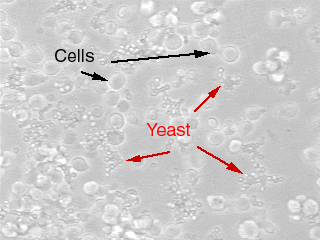Yeast
Yeast in a suspension-type cell culture @ 100x magnification

Description: If you’ve ever enjoyed really good bread and a cold beer (good only in this combination when nothing else is in the fridge) you would agree that, in general, yeast is man’s friend. Yeast is used to ferment the sugars of various grains to produce alcoholic beverages and in the baking industry to expand dough. But in the world of mammalian cell culture, yeast is an unwelcome guest. Yeasts are true fungi of the phylum Ascomycetes Hemiascomycetes. Yeasts have a great number of natural habitates including plant leaves and flowers, soil, and water where they help decompose plant and algal matter, and are also found on the skin surface and in the digestive tract of mammals. They propagate as single cells that divide by budding or direct division and can grow rapidly (doubling times of less than 12 hours in some cases) in contaminated cell cultures.
Characteristics in mammalian cell cultures: In early stages of contamination, yeasts do not typically cause pH changes in the medium. However, as infection increases cell culture medium will become cloudy to the naked eye and the pH may become basic. At 100x magnification yeasts appear as separate round or ovoid particles or in chains of two to four or more particles and can sometimes be multi-branched. The appearance of chains is due to the most common form of replication called budding. Yeasts are easily distinguished from bacteria by size. Yeasts are larger than bacteria and smaller than typical mammalian cells (see example above).
Typical routes of infection in cultures: Initial yeast contamination in cell culture is generally via an airborne route but yeasts can readily “colonize” an incubator and can then be spread to other cultures by contact of contaminated flask or dish surfaces during cell culture manipulation. Yeast is probably the easiest of the common cell culture contaminants to “cure”. Contact the staff at the TCF for recommendations and protocols.
Antibiotics: The two most common antimycotic agents used in cell culture that are effective against yeasts are Amphotericin B (Fungizone) and mycostatin (Nystatin). Important note: routinely used antibiotics such as penicillin/streptomycin (pen/strep), gentamicin, and kanamycin are NOT effective against yeasts. Fungizone can be used in media at final working concentrations between 0.25ug/ml and 2.5ug/ml. Fungizone is typically very toxic in cell culture systems and should be used conservatively. Nystatin can be used at final working concentrations between 100U/ml and 250U/ml. Nystatin is a colloidal suspension rather than a solution and should be mixed thoroughly before it is added to cell culture media. When nystatin is in medium and viewed under a microscope, it will appear as small crystal-like particles. A very useful list of antibiotics, the organisms they are effective against, and recommended working concentrations compiled by the Sigma-Aldrich Company can be found as a pdf document (129Kb, 3 pages) by clicking on the following link. The file will be downloaded and can be opened with Adobe Acrobat Reader. Antibiotic List
